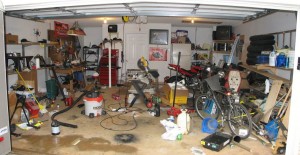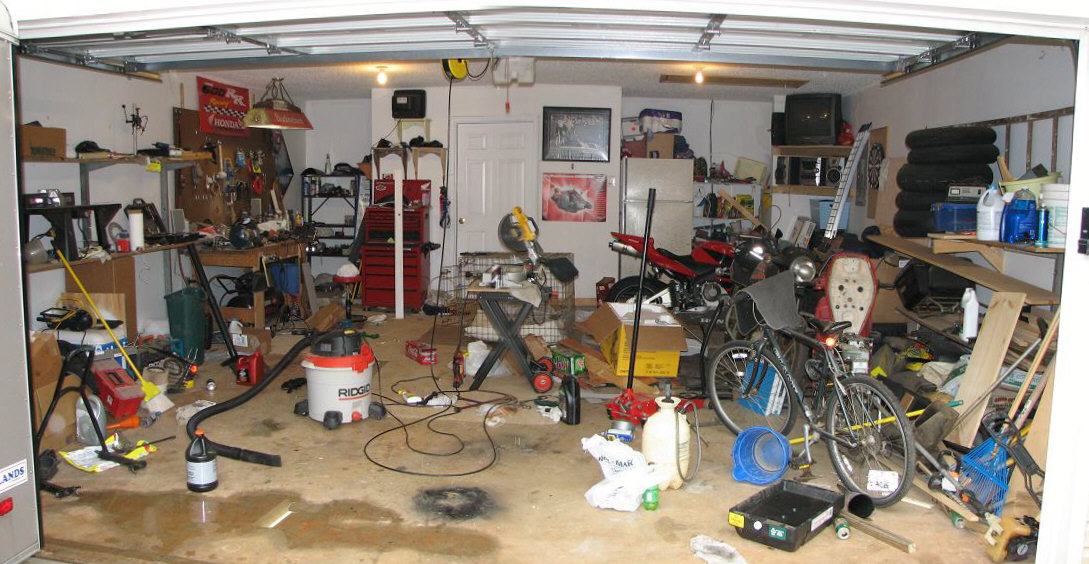How Well Does your Garage Serve it’s Purpose?
July 19, 2010 by
Filed under Blog
Garage Clutter can Drive you Nuts!
When was the last time your garage housed a car? Or, if you do have roo m for a car, how difficult is it to walk around it, and function, with the car in there too? How much stuff do you have to climb over or push aside to find your lawn mower, a yard tool or maybe your washer and dryer?
Wikipedia, online, defines a garage this way: “A residential garage is part of a home, or an associated building, designed or used for storing a vehicle or vehicles.” Are you chu ckling about this yet? Or rolling your eyes in exasperation? Who made up that definition anyway?
This week, we are going to take a good look at a hot problem area in our lives. The reality is that for most of us, our garages are multi-purpose areas, whatever the “proper” definition is! We keep workshops, laundry facilities, storage and clutter in the garage to keep it out of our houses … yet, the fine line between sensible use and overwhelming clutter often sneaks up on us!
So, what in the world are you going to do about that? Here is what you need to d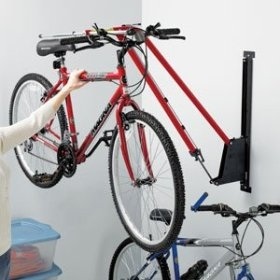 o – plan, organize, plan some more and then voila – a usable, functional space that meets the specific needs of your household.
o – plan, organize, plan some more and then voila – a usable, functional space that meets the specific needs of your household.
First step – Define what you need. Do you have sports equipment that needs storage? Do you buy items in bulk that need to be put away until you want them? Is someone in your family a handy-person, so a workbench becomes a necessity? Do you need room for pet paraphernalia? Does your garage also serve as a place for your washer and dryer? An extra freezer? Once you have defined your own personal needs, you can then focus on techniques for organizing.
The second step to take is photos or notes. Most of us have access to digital cameras or phone cameras. Take pictures of the problem areas, along with notes for solutions. Print or download the pictures, add the notes, and you will see the beginning of a great organization system.
Next, focus on what to keep and what to toss. Do you have a broom with hardly any bristles? Yes, I know, you are very fond of this broom, but come on, it is time for you to let it go! Do you have tennis rackets and balls stashed all over, and you don’t play tennis anymore? List them on Freecycle™, some one else would love to have them!
Now you have the bones of what needs to be done – so let’s “flesh out” the workability of your garage spaces. Here are the three key areas for which to plan ~ Walls, Ceilings and Floor Space. Each has it’s own importance in the organizing scheme.
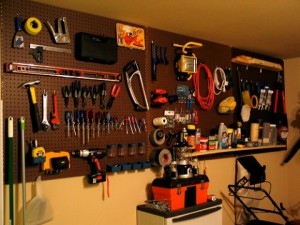 Walls , whether just studs, or finished with sheet rock, can have shelves attached to store items out of the way, and off the floor. Pegboard and handle holders are great sources to hold tools, garden items and mops.
Walls , whether just studs, or finished with sheet rock, can have shelves attached to store items out of the way, and off the floor. Pegboard and handle holders are great sources to hold tools, garden items and mops.
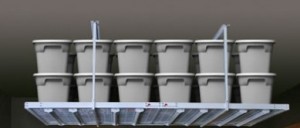 Ceilings can have added use with drop down stor age or permanent storage that provides a place to put seldom used or awkwardly sized or shaped items, such as skis, lumber, or Christmas decorations!
Ceilings can have added use with drop down stor age or permanent storage that provides a place to put seldom used or awkwardly sized or shaped items, such as skis, lumber, or Christmas decorations!
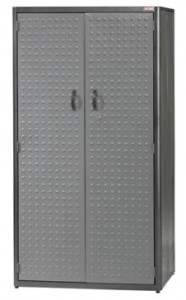 Floor space can, and should, be devoted to things you need access to regularly; garbage cans, your washer and dryer (with shelves overhead!) and your extra freezer or refrigerator. (Do you really need that extra freezer? Most are NOT energy efficient … BUT, more on that next week!)
Floor space can, and should, be devoted to things you need access to regularly; garbage cans, your washer and dryer (with shelves overhead!) and your extra freezer or refrigerator. (Do you really need that extra freezer? Most are NOT energy efficient … BUT, more on that next week!)
Now make the plans become reality. Put up the shelving, the pegboard, the storage items that will make it possible to have neat organization for the items you have decided to keep. Plan to use plastic bins, which come in all sizes, to store perishables (including things like fabric, or crafts) or dangerous chemicals out of reach. Label everything clearly, using a sharpie or label-maker. DATE your labels, as well as making a notation (on the container, or in a notebook) each time you access the bins. Once a year, go through the bins, and if you haven’t accessed them for a year, it is time to discard!
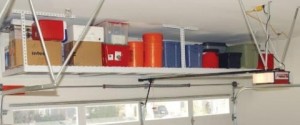 Define each area, so that like things are stored with like! Keep tools together, p et supplies, sports equipment etc. in one accessible place. THEN KEEP THEM THERE! Get in the habit of returning items to the same place each and every time, for easy retrieval next time they are needed. Some folks use colored bins or labels to complete their method of organization – orange bins for Halloween, Red for Christmas, Green for gardening etc. Peg boards can be similarly defined by using colored duct or cloth tape on the handles of tools, designating their use. (Plumbing tools, garden tools, car tools and so forth)
Define each area, so that like things are stored with like! Keep tools together, p et supplies, sports equipment etc. in one accessible place. THEN KEEP THEM THERE! Get in the habit of returning items to the same place each and every time, for easy retrieval next time they are needed. Some folks use colored bins or labels to complete their method of organization – orange bins for Halloween, Red for Christmas, Green for gardening etc. Peg boards can be similarly defined by using colored duct or cloth tape on the handles of tools, designating their use. (Plumbing tools, garden tools, car tools and so forth)
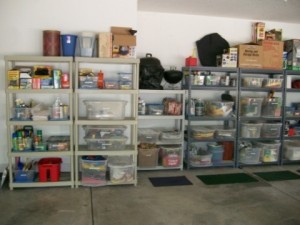 Now, take a moment to stand back and admire your work. How does your garage look now? If someone asked for a specific item, could you find it? Will a car fit in the garage now, should you want it to? Enjoy your feeling of accomplishment, and be sure you maintain the system you have so painstakingly put into place.
Now, take a moment to stand back and admire your work. How does your garage look now? If someone asked for a specific item, could you find it? Will a car fit in the garage now, should you want it to? Enjoy your feeling of accomplishment, and be sure you maintain the system you have so painstakingly put into place.
 Let us help you with your garage. Need a shelf built or hung? Let us build & hang it. Need more lighting or outlets for your new garage setup? We can add it. We are licensed and insured electricians! Need pegboard installed? Let us install it for you! Need muscle to clear out or rearrange your garage? Let us move it for you!
Let us help you with your garage. Need a shelf built or hung? Let us build & hang it. Need more lighting or outlets for your new garage setup? We can add it. We are licensed and insured electricians! Need pegboard installed? Let us install it for you! Need muscle to clear out or rearrange your garage? Let us move it for you!
Repair, Replace, Relax
July 13, 2010 by
Filed under Blog
Keeping on Top of Home Repairs
Our lives are busy, there just is no other way to look at it. And yet, we still have to keep up with repairs and replacements, don’t we? It’s a tough one to deal with and it is becoming increasingly more difficult to keep on top of the repairs and replacements that our homes need to remain functional, enjoyable and valuable in this real estate market. You would think with all the gadgets, technology and equipment we have these days that it would be easier, yet it somehow it is not. Not to mention, this economy has required many of us to cut back, trim our sails, so to speak, and evaluate how we spend our money.
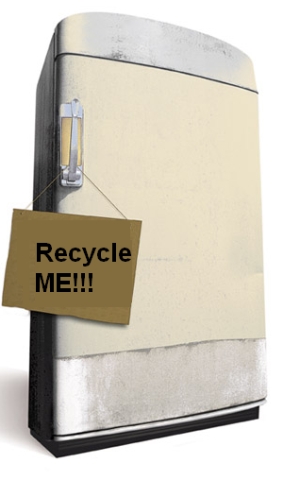 Here are some ideas to assist you in planning your repairs or replacements, the first of which is to look over your appliances and their functionality. In order to remain useful and viable, you need to be aware of the longevity of your appliances, so you can decide when to replace them. Quite often we replace appliances before their useful time is up, doing so during remodels, when we move into a house that is new to us, or when we want a change in design and decor. But you can save money by not replacing things that still have life and usefulness!
Here are some ideas to assist you in planning your repairs or replacements, the first of which is to look over your appliances and their functionality. In order to remain useful and viable, you need to be aware of the longevity of your appliances, so you can decide when to replace them. Quite often we replace appliances before their useful time is up, doing so during remodels, when we move into a house that is new to us, or when we want a change in design and decor. But you can save money by not replacing things that still have life and usefulness!
It’s possible that most of us do not know the longevity of our appliances and are being led to replace them by those who SELL and make a profit on the buying of a new appliance! To assist you, here are some very basic guidelines for expected life on your household appliances:
Dishwashers and Garbage Disposals – 5 to 12 years
Washers and Dryers 8 to 12 years
Refrigerators and Stoves – 15 to 20 years
I can hear you saying – but my dryer is older than that! Of course. These figures are just generalities based on the industry standards. Remember the expression planned obsolescence? That simply means that while manufacturers want you to have a useful and sturdy product, they want you to keep buying, so that the duration of the usefulness of your appliances is factored into the design and purchase price.
What are other factors that determine the length of time your appliances will “live?” Repair, upkeep and portability 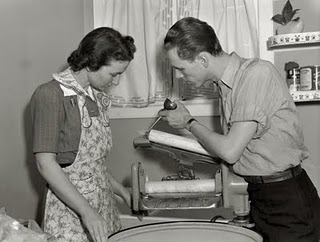 are just some of the keys to keeping appliances working and useful. If you move every couple of years, your washer and dryer, for example, may not last as long, for the jiggling and rough handling in the move certainly affects the condition of your appliances. If you do not take care of routine maintenance, such as keeping dryer vents clean and free of lint, or keeping your refrigerator coils, drain pans, water dispenser hoses and inside cleanliness up to date, then you can be sure of having to replace your appliances more often. In tough economic times, these issues can mean the savings of hundreds, if not thousands, of dollars.
are just some of the keys to keeping appliances working and useful. If you move every couple of years, your washer and dryer, for example, may not last as long, for the jiggling and rough handling in the move certainly affects the condition of your appliances. If you do not take care of routine maintenance, such as keeping dryer vents clean and free of lint, or keeping your refrigerator coils, drain pans, water dispenser hoses and inside cleanliness up to date, then you can be sure of having to replace your appliances more often. In tough economic times, these issues can mean the savings of hundreds, if not thousands, of dollars.
 The next key step to consider is to be aware of the items that are likely to need more frequent attention. Items such as gutters, patio covers, (particularly where they attach to your home,) plumbing, such as toilets and pipes, and routine maintenance of walls and floors which need scheduled maintenance. It is a never ending story of awareness, being in tune with the rhythm of your life, and how it affects your house! The best way to keep on top of these repairs, is to have a viable and up-to-date fix-it list.
The next key step to consider is to be aware of the items that are likely to need more frequent attention. Items such as gutters, patio covers, (particularly where they attach to your home,) plumbing, such as toilets and pipes, and routine maintenance of walls and floors which need scheduled maintenance. It is a never ending story of awareness, being in tune with the rhythm of your life, and how it affects your house! The best way to keep on top of these repairs, is to have a viable and up-to-date fix-it list.
If you find yourself constantly postponing tasks, hire someone, or follow a monthly list of to-dos so that your home gets the attention it needs and deserves, and you get the peace of mind and relaxation that you deserve!
July can be a great month for painting – warm weather means windows can be open for quick drying and dispersion of any odors. Take a look at your driveway, does it need patching, repair or renovation? How about your garage? Take advantage of warm days to clean it out, get rid of junk, build shelving and toss toxic chemicals, checking, of course, with your local city or county for proper disposal methods. You are undoubtedly outside more often now, so take a good look at your fencing. Does it need repair? Do fence posts need replacement? Attention to each of the above mentioned items will increase the usefulness and life of your home, and increase it’s beauty and value.
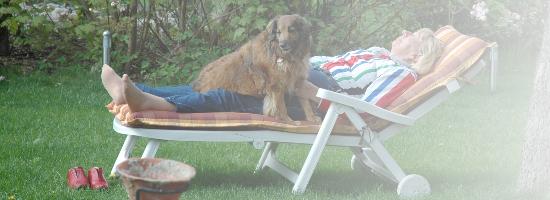 Owning a home, or even renting one, brings with it a set of responsibilities, as well as a set of enjoyable features. As with marriage, children or pets, the tasks required are balanced by the enjoyment you get and the relaxation of knowing that you are aware of the needs, and attentive to them. You deserve a home environment that is relaxing, comforting and secure. Take the steps today to insure that your home gets the attention it deserves.
Owning a home, or even renting one, brings with it a set of responsibilities, as well as a set of enjoyable features. As with marriage, children or pets, the tasks required are balanced by the enjoyment you get and the relaxation of knowing that you are aware of the needs, and attentive to them. You deserve a home environment that is relaxing, comforting and secure. Take the steps today to insure that your home gets the attention it deserves.
 (Let us help you with your indoor or outdoor living needs, especially electrical. We are licensed and insured! Need outside electrical for your new equipment? We can add it. Need a new toilet, or a room painted? We can do that too! Need shelving built? Let us build it for you!)
(Let us help you with your indoor or outdoor living needs, especially electrical. We are licensed and insured! Need outside electrical for your new equipment? We can add it. Need a new toilet, or a room painted? We can do that too! Need shelving built? Let us build it for you!)
Hot New Designs for Outdoor Living
Trends and Design Ideas for Making the Most of your Outdoor Spaces
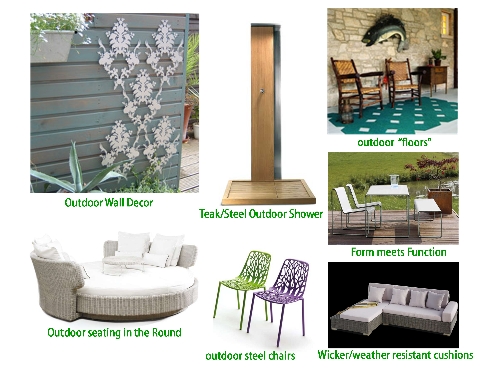
Many of us don’t follow what is happening in design for homes – it is seen as the purview of professional designers and decorators. But there are some exciting new trends happening now that are perfect for creating unusual yet fully functional living spaces out of doors. Industrial designs,>>>>> translated and transformed for home use, indoors and out, are both startling and beautiful in their simplicity. The collage to the right shows some of the newest designs from Italy, Germany and Japan. Inexpensive reproductions of these pieces can be found in many stores in the USA.
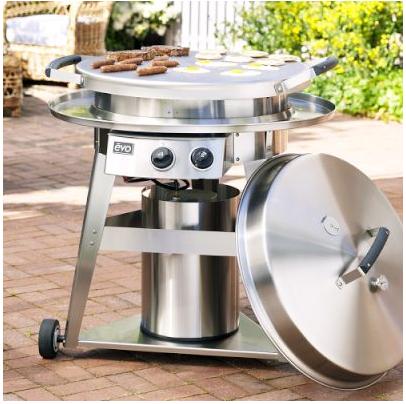
What exactly is Industrial Design? It is a simplistic design, of sturdy materials such as are used in industry. Stainless steel, teak or bamboo, streamlined and esthetically enhanced to be functional in homes, it is both applied art and applied science. Usually very durable, and low maintenance, the initial cost may be higher, but the beauty and ongoing usefulness will make it worth the cost. Since an outdoor environment should be one of comfort and “eye candy,” the use of well designed elements is crucial to the over all look. New materials in barbecues, for example, make them more durable and less work. And since you don’t want to spend hours on upkeep, such streamlined, functional materials will really be great for outdoor use.
Fireplaces, kitchens (with brick pizza ovens), 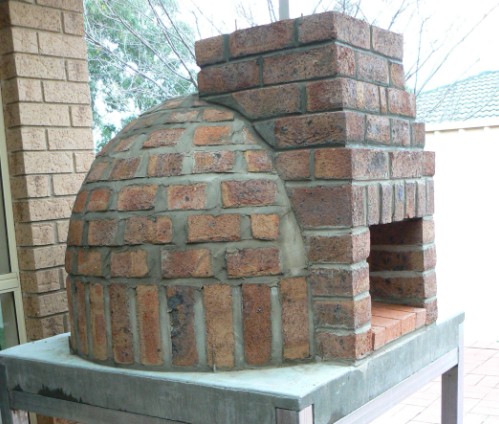
dramatic natural, casual outdoor “living rooms” and a transformation of the American backyard are all trends that are overtaking our consciousness. Many of us are moving away from the traditional lawn and ho-hum, boring conventional landscapes, and exploring new ways to expand our indoor living spaces into our yardscape. We are finally realizing that by utilizing our patios, decks, and pool surrounds for living, we are enabling ourselves to double our living space overall! If you want to raise the value of your home, you need to begin to evaluate ways to add structural interest and comfort to your yard areas – including side yards and covered porches.
More and More, upholstered furniture is the name of the game outdoors. Updated fabrics are virtually weatherproof, and in warmer climes can create a year round ambiance for your outdoor living spaces. In addition to pizza ovens and fireplaces/fire-pits, do consider plenty of seating that embraces the elements of weatherproof fabric, in the colors and patterns that are an extension of your living rooms indoors. Other factors to consider are fans, either the ceiling type in patio covers or cabanas, and water mister systems, that help cool off your yard. These items are readily available, at most home or lumber type hardware stores. Flexibility is also very important – have tables and chairs that are easily moved, to follow the shade! Keep extra cushions and folding or stacking chairs around for extra guests.
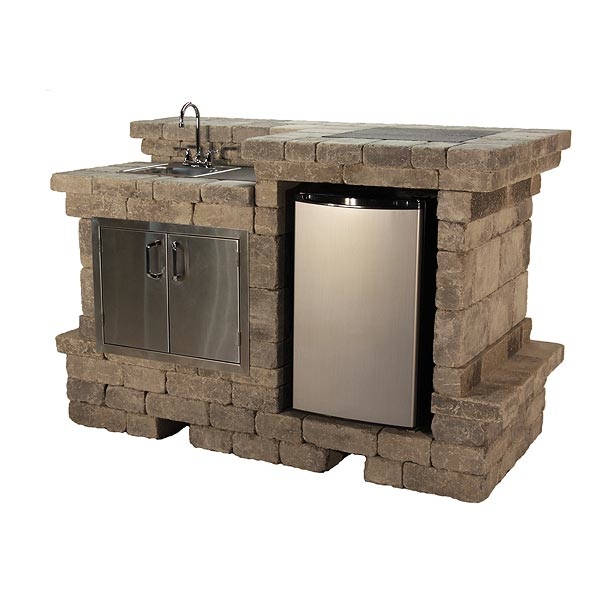 Another important element is a sink or wet bar. Even if you do not serve alcohol, it is nice to have a centralized area with a bar refrigerator, to serve sodas and iced tea. Plan on buying sturdy plastic bar-ware, and avoid disposables which are not at all environmentally friendly! The key in creating your outdoor space is to make it as self-contained and functional as possible, with no in and out of the house scurrying required. These can be purchased, built with brick or made with wood.
Another important element is a sink or wet bar. Even if you do not serve alcohol, it is nice to have a centralized area with a bar refrigerator, to serve sodas and iced tea. Plan on buying sturdy plastic bar-ware, and avoid disposables which are not at all environmentally friendly! The key in creating your outdoor space is to make it as self-contained and functional as possible, with no in and out of the house scurrying required. These can be purchased, built with brick or made with wood.
The most important factor remains being aware of your family’s needs and wants; to create a space that speaks not only to comfort, but to as much use as possible. Create a space you will USE, day in and day out, for family, friends, and for yourself.
 (Let us help you with your outdoor living needs, especially electrical. We are licensed and insured ! Need outside electrical for your new equipment? We can add it. Need a raised flower bed? We can build that too! Need a wet bar? Let us make it for you!)
(Let us help you with your outdoor living needs, especially electrical. We are licensed and insured ! Need outside electrical for your new equipment? We can add it. Need a raised flower bed? We can build that too! Need a wet bar? Let us make it for you!)
